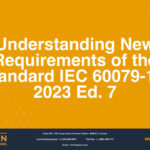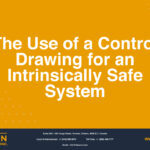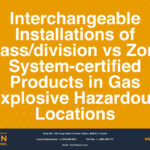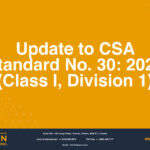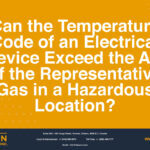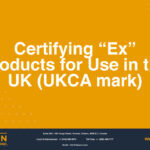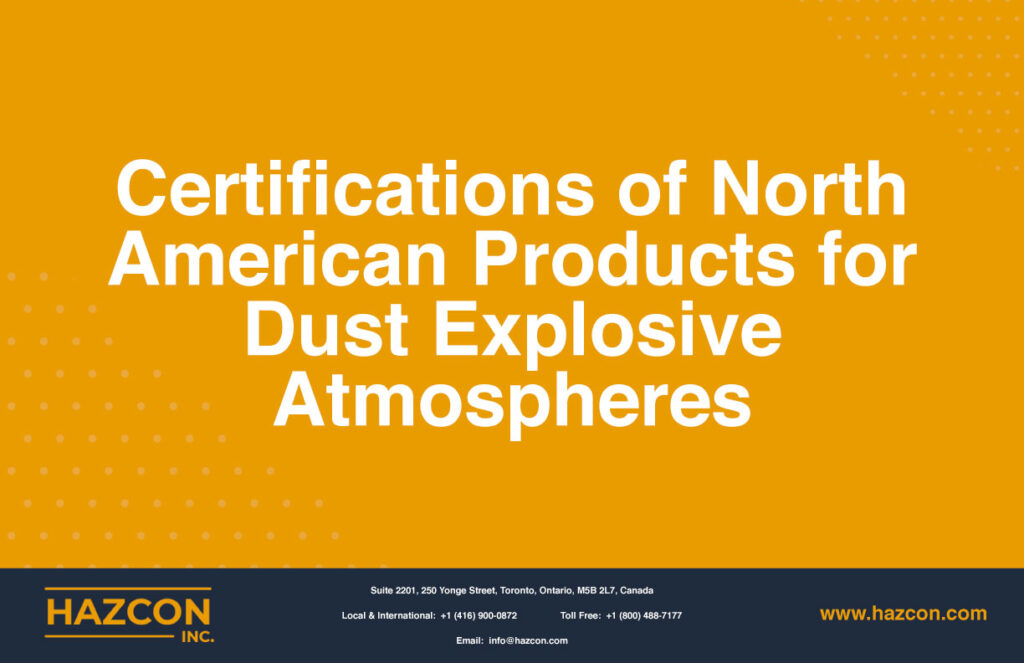
Certifications of North American Products for Dust Explosive Atmospheres
What is a “Dust Explosive Atmosphere”?
Dust explosive atmospheres are locations that are hazardous due to the presence of combustible dusts. Small combustible dust particles can burn easily and rapidly; a sufficient quantity of explosive dusts can cause an explosion.
There are two main concerns related to dust explosive atmospheres: whether or not there is a potential for ignition of a dust cloud, and accumulation of dust on the surface of equipment (called “thermal blanketing”) which might interfere with the safe dissipation of heat from the electrical equipment on which it accumulates.
Two main ignition sources in dust explosive atmospheres are hot surfaces (which can be a result of hot particles, welding, naked flame or overheated parts such as bearings), and sparks (which can be generated as a result of electrical equipment, static, mechanical failure leading to impact or friction, cutting and grinding operations).
How are Dust Explosive Atmospheres grouped in North America?
Several characteristics of explosive dusts are considered when they are classified or grouped together:
– Their physical properties and types of materials involved
– Their electrical resistivity (Standard IEC 60079-10-2, clause 3.6 defines conductive dust as combustible dust with electrical resistivity equal to or less than 103 Ωm)
– The effect of layers of the dust that can accumulate on equipment
– Grades of releases of explosive dusts during normal operation and maintenance (that is, how often per year the explosive dusts might be expected to be released to the atmosphere)
In North America, there are two systems used to classify or group explosive dusts: the Class/Division system and the Zone System. The Class-Division system for dust explosive atmospheres is based on the NFPA 499 Standard. Standard IEC 60079-10-2 provides area classifications for the Zone system.
The Class/Division System
Explosive dusts are identified as Class II in the North American Class/Division system. The Canadian Electrical Code (CEC) and the National Electrical Code in the U.S. (NEC) define Class II, Division 1 (known as C2D1) as a location in which combustible and explosive dusts are in the air under normal operating condition in quantities sufficient to produce explosive or ignitable mixtures. Class II, Division 2 (known as C2D2) is defined as a location where combustible and explosive dusts are not normally in the air in quantities sufficient to generate explosive or ignitable mixtures, but the ignitable dusts may be suspended in the air as a result of infrequent malfunctioning of the processing equipment.
There are three Dust Groups (E, F and G) in North America. Dust Group E are combustible metal dusts; Dust Group F consists of combustible dust other than combustible metal dust; and Dust Group G are solid particles, including fibres.
The Zone System
In the Zone system, explosive dusts are identified as Group III. The Zone system further divides Group III into three zones (Zone 20, Zone 21, and Zone 22). Zone 20 is defined by the Canadian Electrical Code (CEC) and the National Electrical Code in the U.S. (NEC) as a location in which ignitable concentrations of combustible dust or ignitable fibres/ flyings are present continuously or for long periods of time under normal operating conditions. Zone 21 is a location where ignitable concentrations of combustible dust or ignitable fibres/flyings are likely to exist occasionally under normal operating conditions. Zone 22 is a location in which ignitable concentrations of combustible dust or ignitable fibres/flyings are not likely to occur under normal operating conditions.
There are three dust groups: Groups IIIC, IIIB, and IIIA. Similar to the Division/Class system, explosive dusts that are identified as IIIC are combustible metal dusts; IIIB are combustible dust other than combustible metal dust; and IIIA are solid particles, including fibres.
What Protection Techniques are Used for Electrical Equipment in Dust Explosive Atmospheres?
Class/Division System Protection Techniques
In the Class/Division system, the most common protection technique used in Class II, Division 1 hazardous locations is “dust-ignition proof”. The main concept behind this technique is that the electrical equipment is built in a way that prevents the ignitable dust from entering into the equipment. The equipment, by design, will also not permit arcs, sparks, or heat generated or liberated inside of the enclosure to cause ignition of exterior accumulations or atmospheric suspensions of a specified dust on or in the vicinity of the enclosure. The “dust- ignition proof” technique is based on UL 1203 or FM 3616 Standard for the U.S. and CSA C22.2 No. 25 Standard for Canada.
Other techniques used in the Class/Division system for “Class II, Division 1” equipment are:
• Intrinsic safety, as per Standards UL 913 for the USA and CSA C22.2 No. 60079-11 for Canada
• Purged and pressurized Type X or Y as per Standard NFPA 496 for both Canada and the USA
The main protection techniques used for “Class II, Division 2” equipment are:
• Dust-tight, hermetically sealed, and non-incendive techniques as per UL 121201 for the USA and CSA C22.2 No. 213
• Purged and pressurized Type Z as per Standard NFPA 496 for both Canada and the USA.
• And all the “Class II, Division 1” protection techniques
Protection Techniques for the Zone System
Based on the degree of risk involved, each Zone requires a different explosion protection level (EPL).
Zone 20 Protection Techniques
The main protection techniques that can be implemented for Zone 20 equipment are:
• Protection by enclosure (Ex ta with EPL Da) as per Standards UL 60079-31 for the USA and CSA C22.2 No. 60079-31 for Canada
• Intrinsic safety (Ex ia with EPL Da) as per Standards UL 60079-11 for the USA and CSA C22.2 No. 60079-11 for Canada
• Protection by encapsulation (Ex ma with EPL Da) as per Standards UL 60079-18 for the USA and CSA C22.2 No. 60079-18 for Canada
Products having a “Class II, Division 1” marking with a valid certificate from an accredited agency in North America can also be installed in Zone 20 hazardous areas in North America.
Zone 21 Protection Techniques
The main protection techniques that can be implemented for Zone 21 equipment are:
• Protection by enclosure (Ex tb with EPL Db) as per Standards UL 60079-31 for the USA and CSA C22.2 No. 60079-31 for Canada
• Intrinsic safety (Ex ib with EPL Db) as per Standards UL 60079-11 for the USA and CSA C22.2 No. 60079-11 for Canada
• Protection by encapsulation (Ex mb with EPL Db) as per Standards UL 60079-18 for the USA and CSA C22.2 No. 60079-18 for Canada
• Purged and pressurized (Ex pxb and Ex pyb with EPL Db) as per Standards UL 60079-2 for the USA and CSA C22.2 No.60079-2 for Canada
Products having a “Class II, Division 1” marking and certified for Zone 20 with EPL Da with a valid certificate from an accredited agency in North America can also be installed in Zone 20 hazardous areas in North America.
Examples of Markings in the Class/Division System:
- Class II, Division 1, Groups E, F, G
- Class II, Division 2, Groups F, G (Note: explosive conductive metal duct “Group E” is only for Division 1)
Examples of Markings in the Zone System:
For Canada:
- Ex ta IIIC T100°C Da (Using Protection by Enclosure technique)
- Ex ib IIIC T100°C Db (Using Intrinsic Safety technique)
- Ex mc IIIC T100°C Dc (Using Encapsulation technique)
For the USA:
- Zone 20, AEx ta IIIC T100°C Da (Using Protection by Enclosure technique)
- Zone 21, AEx ib IIIC T100°C Db (Using Intrinsic Safety technique)
- Zone 22, AEx mc IIIC T100°C Dc (Using Encapsulation technique)
Class/Division and Zone Markings Applied to Products Certified in North America
For any North American hazardous location certification, the equipment must first comply with the general safety, also known as ordinary location, as well as the requirements of the hazardous environment. Ordinary location requirements are specific for each type of electrical equipment and cover general safety requirements such as risk of electrical shock, fire hazards and injuries.
“Class II Division 1 or 2” products are electrical devices approved for use in a hazardous location Class-Division system in North America. They can be manufactured anywhere in the world but, because they are based on the North America classification system of Classes and Divisions, are approved only by North American certifying agencies for use in Canada and the U.S.
A product can be approved for North American Zone marking or a valid existing IECEx certificate issued by a recognized certification body can be used as a basis of Zone marking for North America. However, the product must comply additional with North American requirements which are: the ordinary location requirements, hazardous locations national deviation in North America and wiring restrictions per CEC and NEC.
Products with “Class II, Division 1” marking are permitted to be installed in Zones 20, 21, 22 areas. Similarly, products with “Class II, Division 2” marking are only allowed to be installed in Zone 22. Products approved for Zone 20 with EPL Da are allowed to be installed in “Class II, Division 1” and “Class II, Division 2” areas. Products approved for Zone 21 (with EPL Db) and 22 (with EPL Dc) can only be installed in “Class II, Division 2”.
Request a Consultation
Complete the form below to get started.

